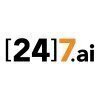Filter interviews by
Salesforce Developer Support Engineer Interview Questions and Answers
Salesforce Developer Support Engineer Interview Experiences
2 interviews found
I applied via Company Website and was interviewed in Aug 2023. There were 2 interview rounds.

(5 Questions)
- Q1. 1) Custom Settings & Custom Meta data difference
- Ans.
Custom Settings are hierarchical data that can be accessed using Apex code, while Custom Metadata are records that can be accessed using SOQL queries.
Custom Settings are hierarchical data that can be accessed using Apex code, while Custom Metadata are records that can be accessed using SOQL queries.
Custom Settings are used to store data that is organization-specific, while Custom Metadata is used to store metadata that...
- Q2. 2) Diff bn Queable and future apex
- Ans.
Queueable and Future Apex are both ways to run processes asynchronously in Salesforce, but they have some key differences.
Queueable allows chaining of jobs and implements the Queueable interface, while Future Apex does not support chaining.
Queueable jobs can be monitored and managed through the Apex Jobs page in Salesforce, while Future Apex jobs cannot be monitored in the same way.
Queueable jobs have a limit of 50 job...
- Q3. 3) Write a trigger on child if the all related child status is closed then update that in parent object
- Ans.
Create a trigger on child object to update parent object when all related child records have a closed status.
Create a trigger on the child object to run before insert and update events.
Query all related child records in the trigger context.
Check if all child records have a closed status.
Update the parent object if all child records have a closed status.
- Q4. Batch apex scenario
- Q5. Decorators in lwc
- Ans.
Decorators in LWC are used to add metadata to class properties or methods.
Decorators are declared with the @ symbol before the name, like @api or @wire.
They are used to define public properties, wire adapters, and event handlers in LWC.
Example: @api property or @wire(getRecord, { recordId: '$recordId' }) wired method.
Skills evaluated in this interview
Interview Questionnaire
1 Question
- Q1. Each and every topic in detail. Like batch, trigger, different between process builder and workflow, lightning in detail, different between database.insert & insert, offset, Integration in detail, REST & ...
Interview Preparation Tips
Top trending discussions






Interview questions from similar companies

I applied via Company Website and was interviewed before Oct 2019. There were 4 interview rounds.
Interview Questionnaire
1 Question
- Q1. 1. Core Java - OOPS features, Abstract classes and Interface, Inner Classes, String and Object Class, Equals and HashCode methods, Runtime and Compile time exception, Method overloading and overriding, Cus...
Interview Preparation Tips
2. Basic DB queries
3. Basic Unix commands

Software Engineer Interview Questions & Answers
Microsoft Corporationposted on 16 Sep 2021
I appeared for an interview before Sep 2020.
(1 Question)
Round duration - 50 minutes
Round difficulty - Easy
This was a Data Structural round.
- Q1.
Distinct Islands Problem Statement
Given a two-dimensional array/list consisting of integers 0s and 1s, where 1 represents land and 0 represents water, determine the number of distinct islands. A group of...
- Ans.
Count the number of distinct islands in a 2D array of 0s and 1s.
Identify islands by performing depth-first search (DFS) on the grid
Use a set to store the shape of each island and check for duplicates
Consider translations to determine distinct islands
(1 Question)
Round duration - 50 minutes
Round difficulty - Easy
This was a Data Structural round.
- Q1.
Word Wrap Problem Statement
You are tasked with arranging 'N' words of varying lengths such that each line contains at most 'M' characters, with each word separated by a space. The challenge is to minimiz...
- Ans.
The goal is to minimize the total cost of arranging 'N' words on each line with a maximum character limit 'M'.
Calculate the cost of each line as the cube of extra space characters needed to reach 'M'.
Minimize the total cost by arranging words to fit within the character limit on each line.
Ensure each word appears fully on one line without breaking across lines.
(1 Question)
Round duration - 60 minutes
Round difficulty - Easy
This was a System Design round.
- Q1. Can you design a system similar to Red Bus that can handle bookings and onboard both vendors and customers to the platform?
- Ans.
Design a system similar to Red Bus for handling bookings and onboarding vendors and customers.
Implement a user-friendly interface for customers to search and book tickets
Create a vendor portal for vendors to manage their offerings and availability
Include payment gateway integration for secure transactions
Develop a robust backend system for managing bookings, cancellations, and refunds
Utilize a database to store user in...
Round duration - 50 minutes
Round difficulty - Easy
This was a System Design round
Round duration - 50 minutes
Round difficulty - Easy
This was an HR round.
Interview Preparation Tips
Tip 1 : Practice as much as you can.
Tip 2 : Prepare for company, not in general.
Tip 3 : Your past work should be objective and your contribution should be very clear
Tip 1 : Keep only relevant things for the job you are applying.
Tip 2 : Minimal data with measurable contribution and effect.
Skills evaluated in this interview

I applied via Monster and was interviewed before Apr 2020. There was 1 interview round.
Interview Questionnaire
1 Question
- Q1. Basic java
Interview Preparation Tips

Interview Questionnaire
8 Questions
- Q1. WRITE A GENERIC SWAP FUNCTION
- Ans.
A generic swap function swaps two values of any data type.
The function should take two parameters of any data type.
Use a temporary variable to store the value of one parameter.
Assign the value of the second parameter to the first parameter.
Assign the value of the temporary variable to the second parameter.
- Q2. SEARCH AN ELEMENT IN ROTATED SORTED LINKLIST .
- Ans.
Search for an element in a rotated sorted linked list.
Find the pivot point where the list is rotated.
Divide the list into two sublists based on the pivot point.
Perform binary search on the appropriate sublist.
Handle edge cases such as empty list and list with only one element.
- Q3. SEARCH AN ELEMENT IN ROTATED SORTED ARRAY. WRITED A CODE FOR IT
- Ans.
Search an element in a rotated sorted array
Find the pivot point where the array is rotated
Divide the array into two sub-arrays based on pivot point
Perform binary search on the appropriate sub-array
Repeat until element is found or sub-array size is 1
- Q4. In an Array of size 95 contain numbers in range 1 to 100. each number is at max once in the array. find the 5 missing numbers in array between 1-100
- Q5. Given sudoku as id array of size . in a given empty cell find the possible numbers that could be possible. Asked me to write code for it
- Ans.
Given a Sudoku board, find possible numbers for an empty cell.
Iterate through empty cells and check possible numbers using row, column, and box constraints.
Use a set to keep track of possible numbers for each empty cell.
Return the set of possible numbers for the given empty cell.
- Q6. Given 4 unsigned integers find their integer average (eg. (2,2,2,3) => (2+2+2+3)/4 = 2) consider integer division ) without typecasting
- Ans.
Find integer average of 4 unsigned integers without typecasting
Add all the integers and divide by 4
Use bit shifting to divide by 4
Handle overflow by using long long data type
Use unsigned int data type for input
- Q7. Write a code to identify wheter given processor is of 32 bit architecture or 64 bit architecture
- Ans.
Code to identify 32 bit or 64 bit architecture of a processor
Check if the operating system is 32 bit or 64 bit
If OS is 32 bit, processor is 32 bit
If OS is 64 bit, check if processor supports 64 bit architecture
Use CPUID instruction to check if processor supports 64 bit architecture
- Q8. Convert a binary number into base 64 integer
- Ans.
Convert binary number to base 64 integer
Divide the binary number into groups of 6 bits
Convert each group of 6 bits to decimal
Map the decimal value to the corresponding base 64 character
Concatenate the base 64 characters to form the final integer
Interview Preparation Tips
Experience: SIMPLE CODING QUESTIONS SPEED MATTERS.
Duration: 60 minutes
Total Questions: 3
Skills: Analytics And Coding
College Name: IIT Guwahati
Skills evaluated in this interview

Interview Questionnaire
6 Questions
- Q1. Solving puzzles(25 horses,ant and sweets,height of a building..) try as many as possible before appearing for interview
- Q2. If experienced , then project details of previous companies a must prepare question
- Q3. Writing test cases for random scenarios
- Ans.
Creating test cases for random scenarios ensures software reliability and robustness through diverse input validation.
Identify edge cases: Test with minimum and maximum input values, e.g., an empty array vs. a large array.
Use random data: Generate random inputs to simulate real-world usage, e.g., random user names or passwords.
Test invalid inputs: Ensure the system handles unexpected inputs gracefully, e.g., negative n...
- Q4. Programming in whatsoever language you r comfortable with, basic coding problems of DS,Algos. eg. Zigzag tree traversal algo,random linked list copy
- Q5. Some people asked me questions related to the work i will do if hired in the project
- Q6. Be genuine in ur CV, and be prepared with everything you write there.
Interview Preparation Tips

I appeared for an interview before Mar 2021.
(2 Questions)
Round duration - 45 minutes
Round difficulty - Medium
Technical Interview round with questions on DSA.
- Q1.
Reverse Words in a String: Problem Statement
You are given a string of length
N. Your task is to reverse the string word by word. The input may contain multiple spaces between words and may have leading o... - Q2.
Reverse a Stack Using Recursion
You are given a stack of integers. Your task is to reverse the stack using recursion without using any extra space other than the internal stack space used due to recursion...
- Ans.
Reverse a stack using recursion without using any extra space other than the internal stack space.
Use recursion to pop all elements from the original stack and store them in function call stack.
Once the stack is empty, push the elements back in reverse order.
Base case of recursion should be when the original stack is empty.
(2 Questions)
Round duration - 45 minutes
Round difficulty - Medium
Technical Interview round with questions on DSA.
- Q1.
Convert a Binary Tree to its Mirror Tree
Given a binary tree, convert this binary tree into its mirror tree. A binary tree is a tree in which each parent node has at most two children. The mirror of a bin...
- Ans.
Convert a binary tree to its mirror tree by interchanging left and right children of all non-leaf nodes.
Traverse the binary tree in a recursive manner.
Swap the left and right children of each non-leaf node.
Continue this process until all nodes have been processed.
- Q2.
Remove Nth Node from End of Linked List
You are given a singly linked list with 'N' nodes, each containing integer data, and an integer 'K'. Your goal is to remove the 'K'th node counting from the end of ...
- Ans.
Remove the Kth node from the end of a singly linked list.
Use two pointers approach to find the Kth node from the end.
Handle edge cases like removing the head node or removing the last node.
Update the pointers to remove the Kth node and reconnect the list.
Round duration - 30 minutes
Round difficulty - Easy
Typical Managerial round.
Interview Preparation Tips
Tip 1 : Must do Previously asked Interview as well as Online Test Questions.
Tip 2 : Go through all the previous interview experiences from Codestudio and Leetcode.
Tip 3 : Do at-least 2 good projects and you must know every bit of them.
Tip 1 : Have at-least 2 good projects explained in short with all important points covered.
Tip 2 : Every skill must be mentioned.
Tip 3 : Focus on skills, projects and experiences more.
Skills evaluated in this interview

Interview Preparation Tips
College Name: NIT SURATHKAL

Interview Preparation Tips
Experience: Oracle had an online test which includes 3
Sections:
1. Programming: basic C++/java programming + data structure. One need to have good hand over oops
to score well in this section.
2. Aptitude: General Aptitude Questions
3. General Maths: Very simple maths problem (+2 level) but needs very very good speed.
Tips: Individual cutoff was not declared, but different cutoff for different profile is expected.
Oracle has no GD round.
Round: Interview
Experience: In 2nd round of interview, there was more programming, less resume based question and more emphasis on will I be comfortable in an IT sector. Some apti questions were also asked.
Round: Interview
Experience: 1st round was completely on resume based. Each and every project and intern is discussed in detail. Most of the extracurricular activities were also discussed. In the 1st interview, some basic program like fibonacci series by recursion, star pattern by loop etc were asked.
Round: Interview
Experience: Next round was HR. I was asked about the earlier 2 interviews and some basic HR questions.
College Name: IIT Roorkee
Salesforce Interview FAQs
Tell us how to improve this page.
Salesforce Interviews By Designations
- Salesforce Technical Support Engineer Interview Questions
- Salesforce Member Technical Staff Interview Questions
- Salesforce Software Developer Interview Questions
- Salesforce Mts Software Engineer Interview Questions
- Salesforce Support Engineer Interview Questions
- Salesforce Salesforce Developer Interview Questions
- Salesforce Technical Consultant Interview Questions
- Salesforce Associate Technical Support Engineer Interview Questions
- Show more
Overall Interview Experience Rating
based on 1 interview experience
Difficulty level
Duration
Interview Questions from Similar Companies
Salesforce Developer Support Engineer Reviews and Ratings
based on 10 reviews
Rating in categories
|
Technical Support Engineer
961
salaries
| ₹15 L/yr - ₹26 L/yr |
|
Technical Consultant
430
salaries
| ₹17.6 L/yr - ₹29.8 L/yr |
|
Senior Technical Consultant
350
salaries
| ₹26.6 L/yr - ₹45.5 L/yr |
|
Member Technical Staff
348
salaries
| ₹31.5 L/yr - ₹57.3 L/yr |
|
Senior Member of Technical Staff
317
salaries
| ₹48 L/yr - ₹87.3 L/yr |

SAP

Zoho

Oracle

Adobe
- Home >
- Interviews >
- Salesforce Interview Questions












